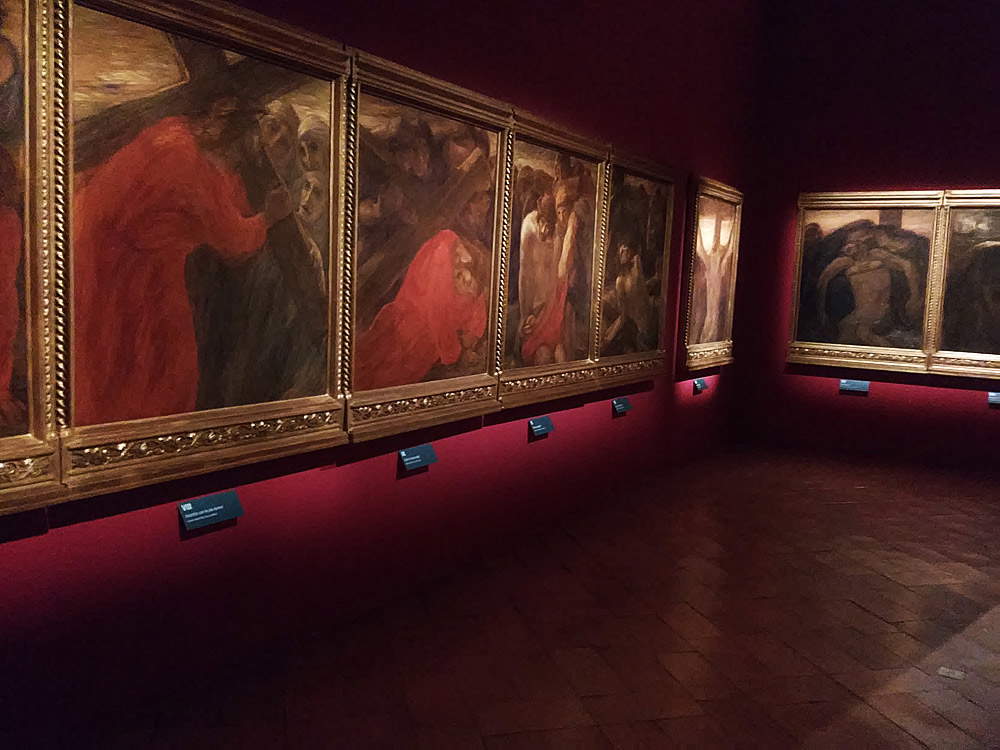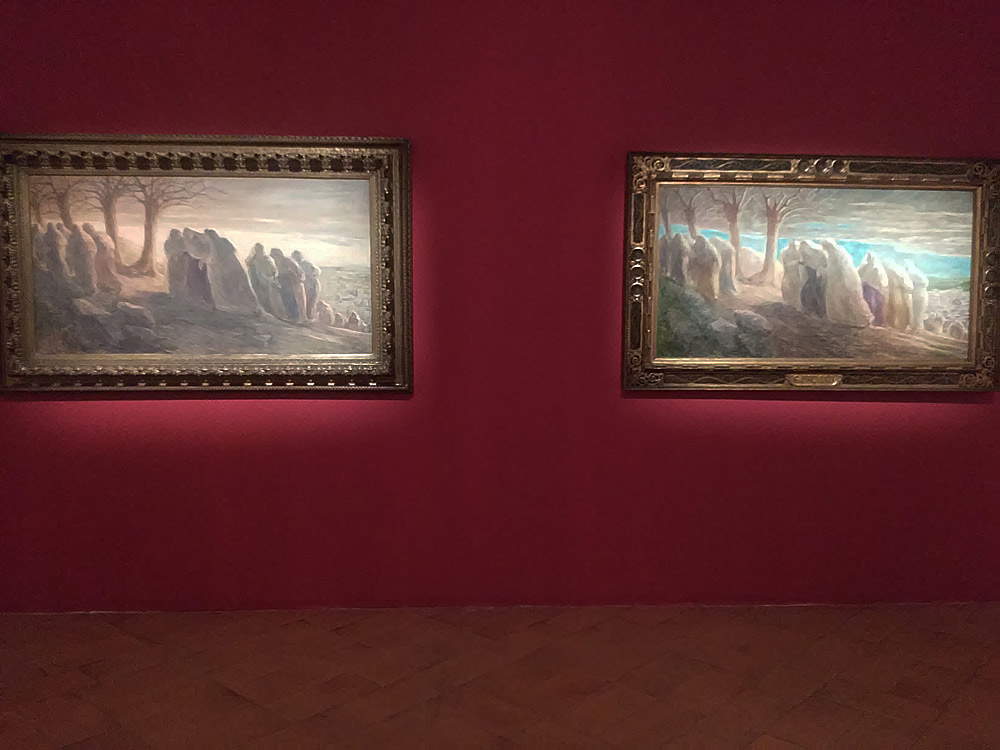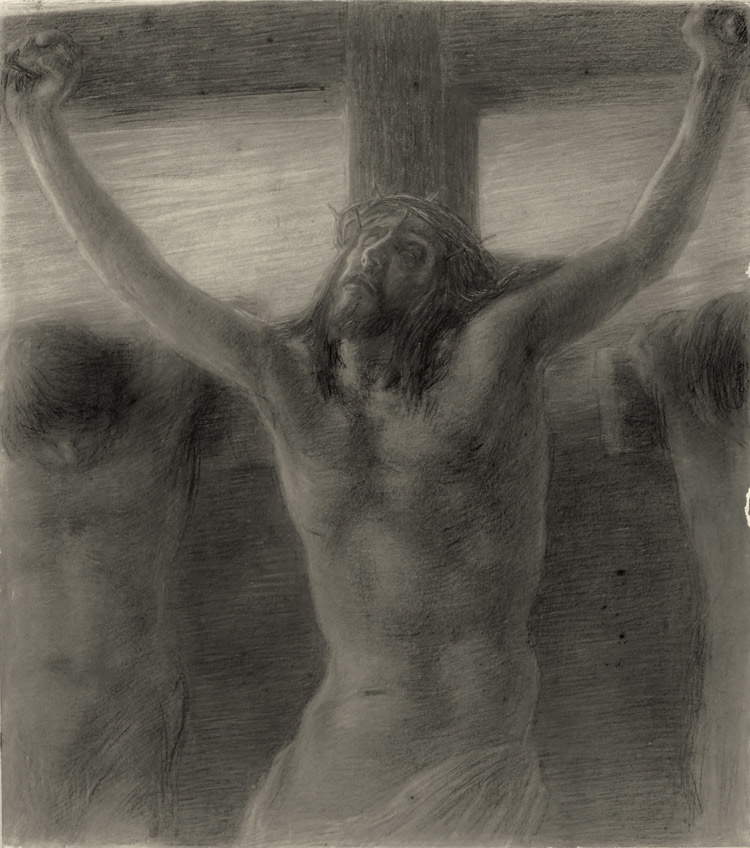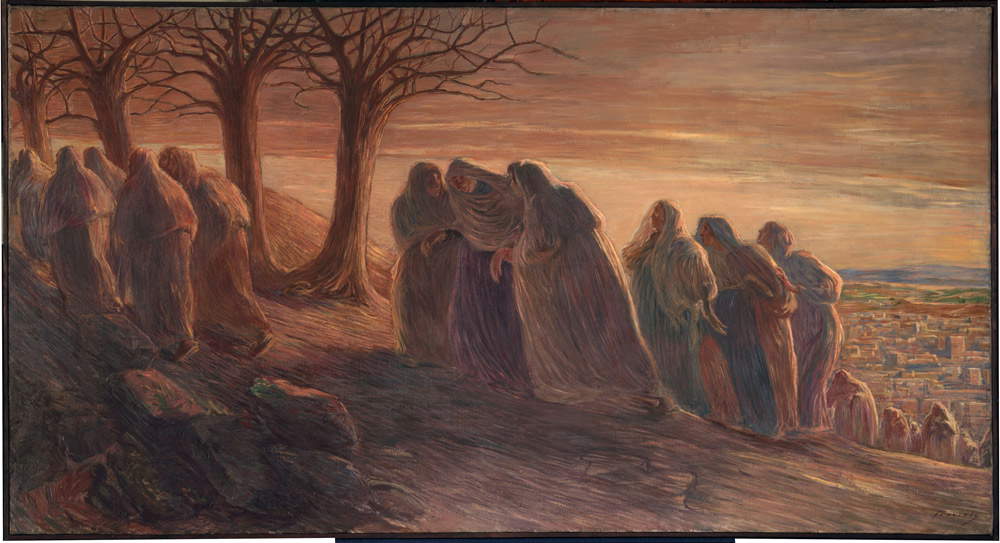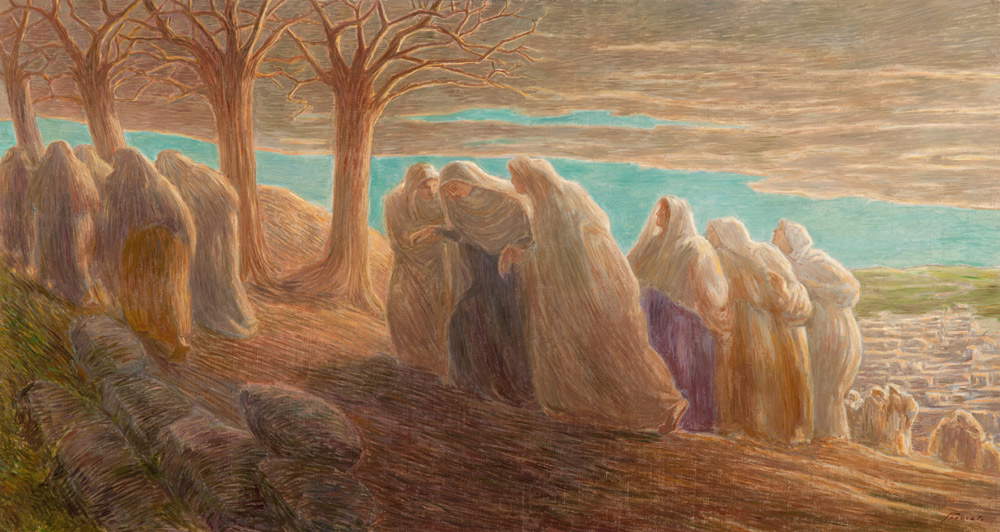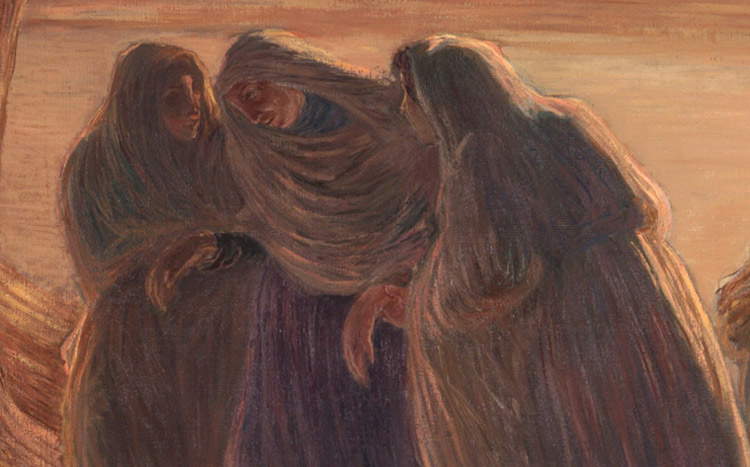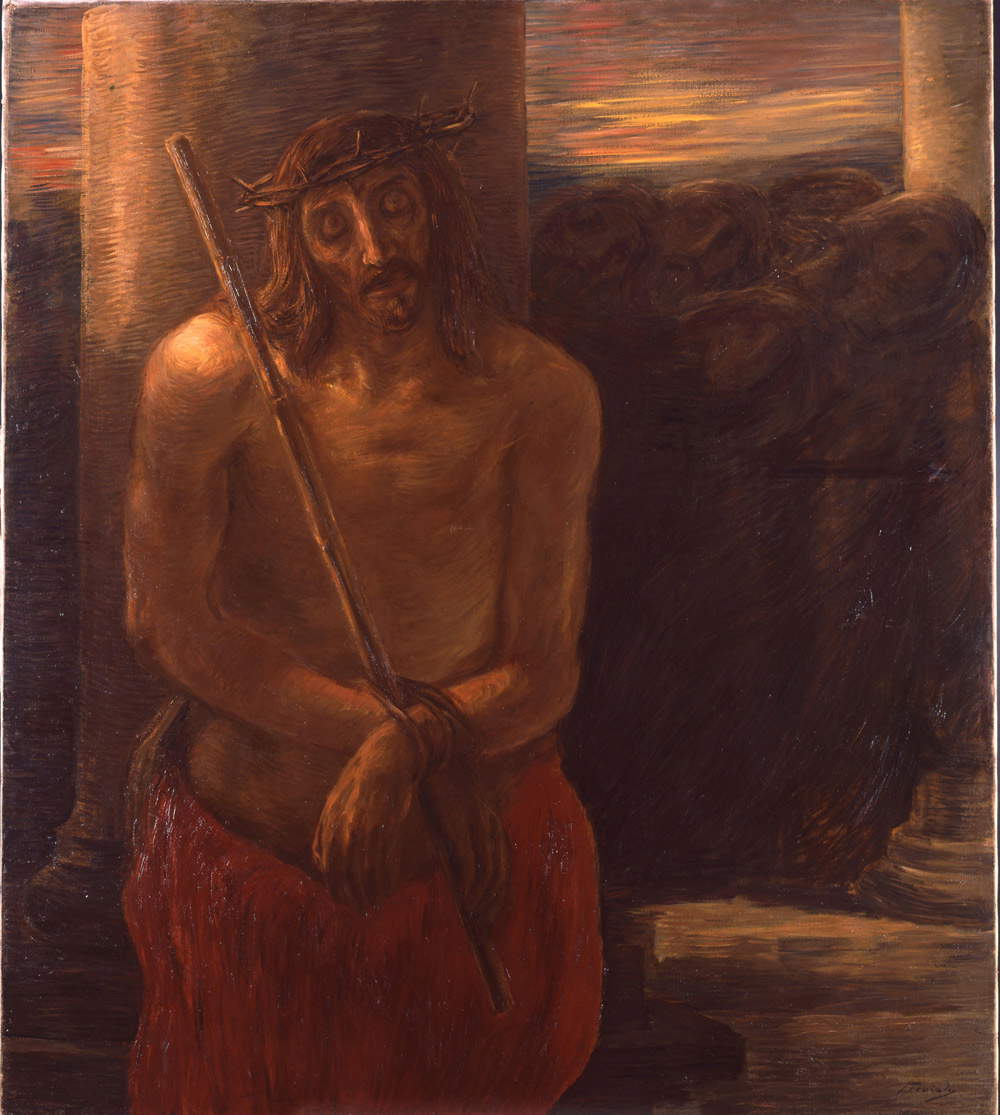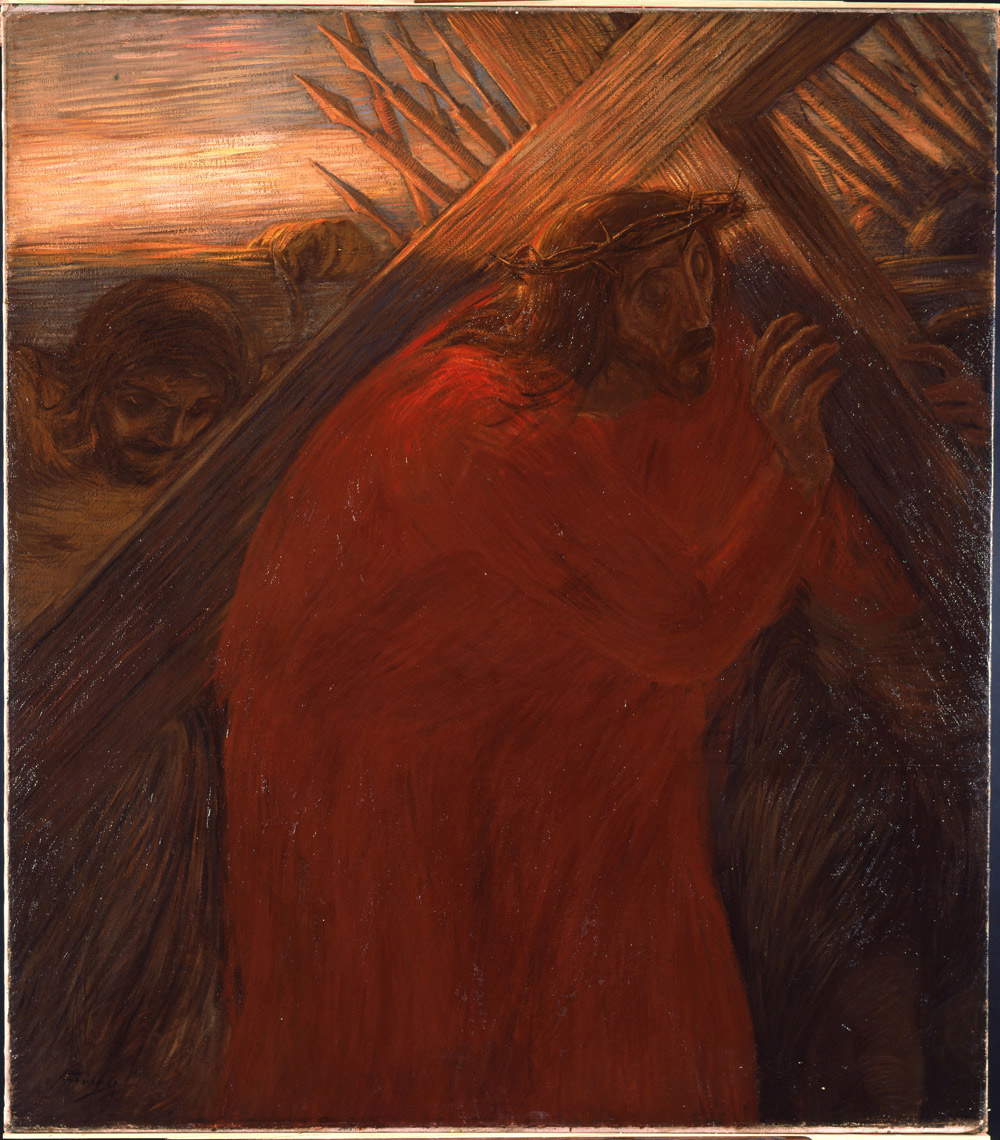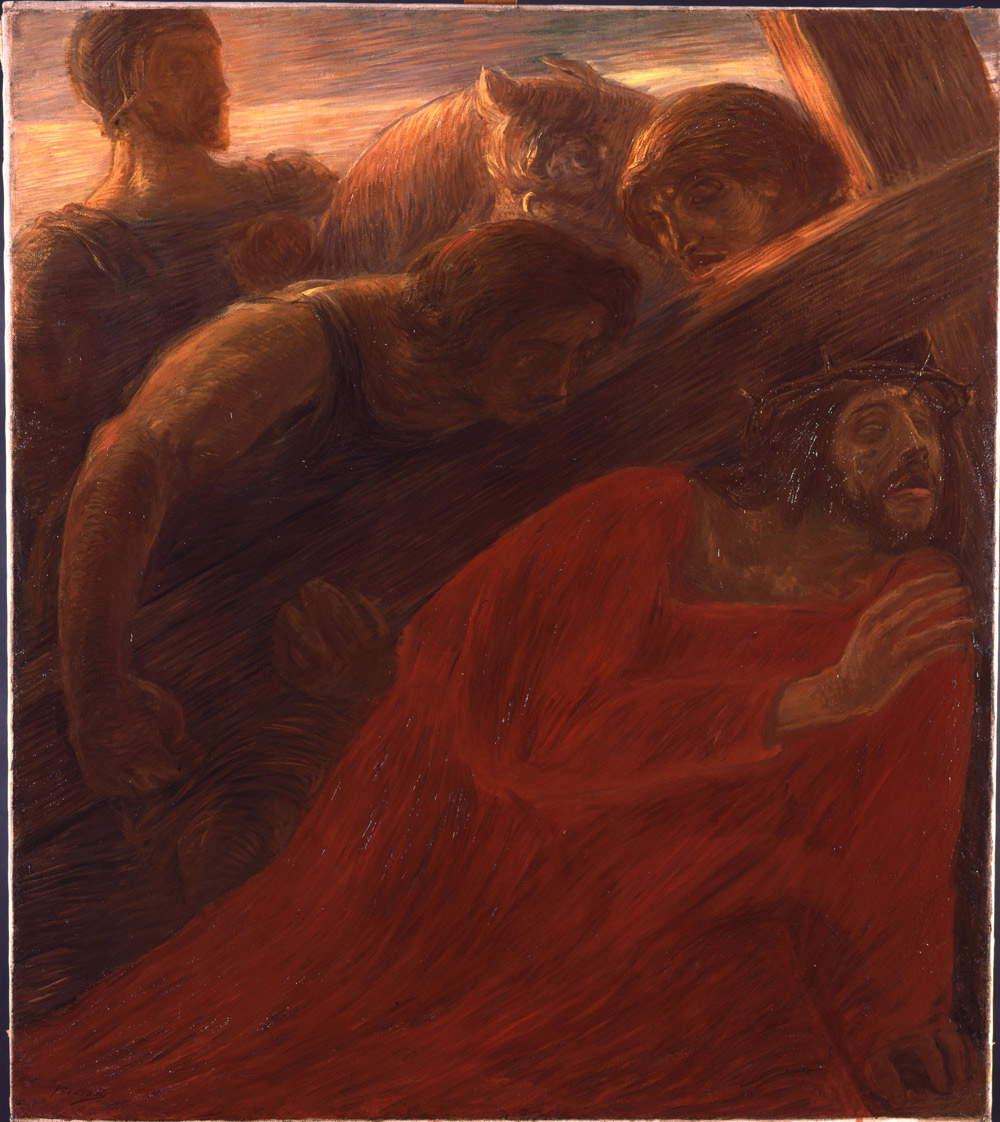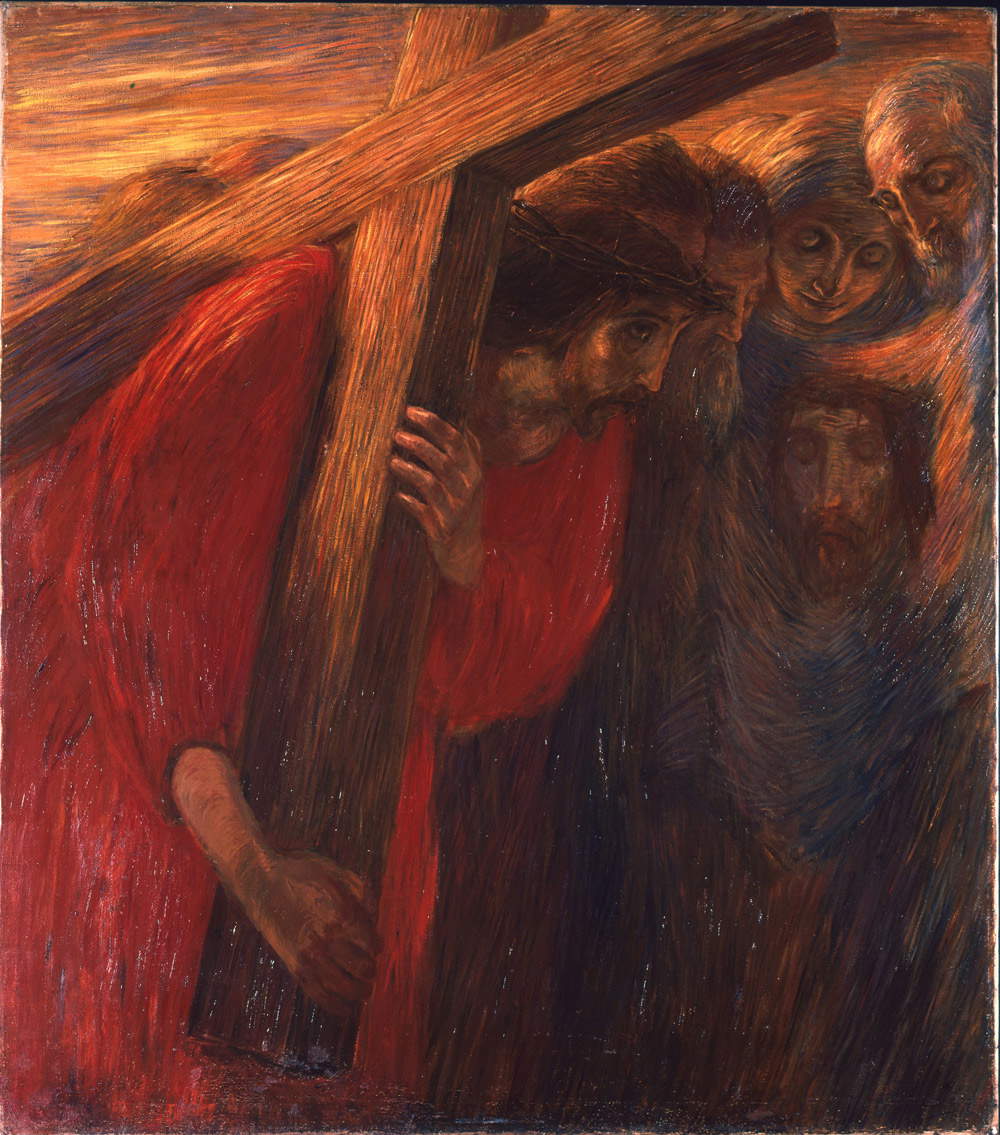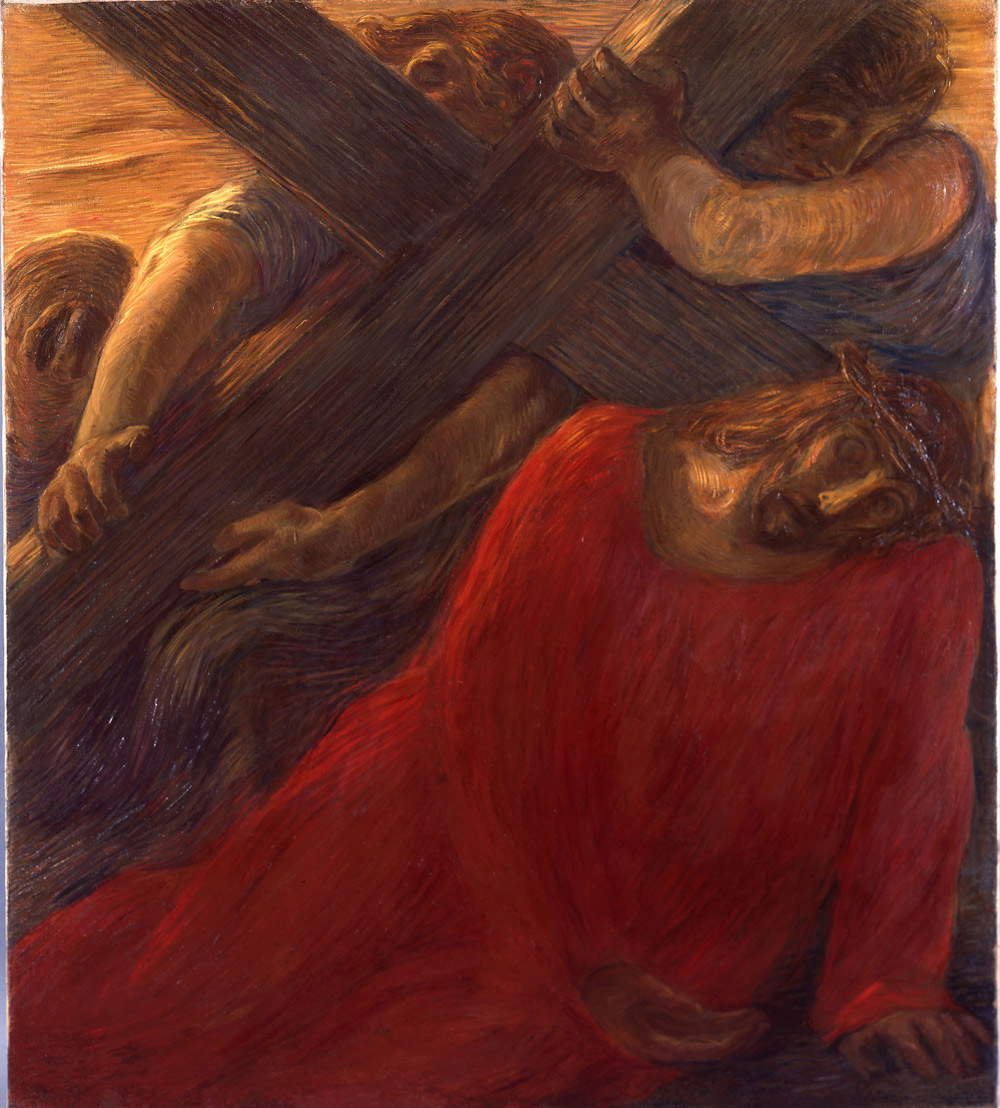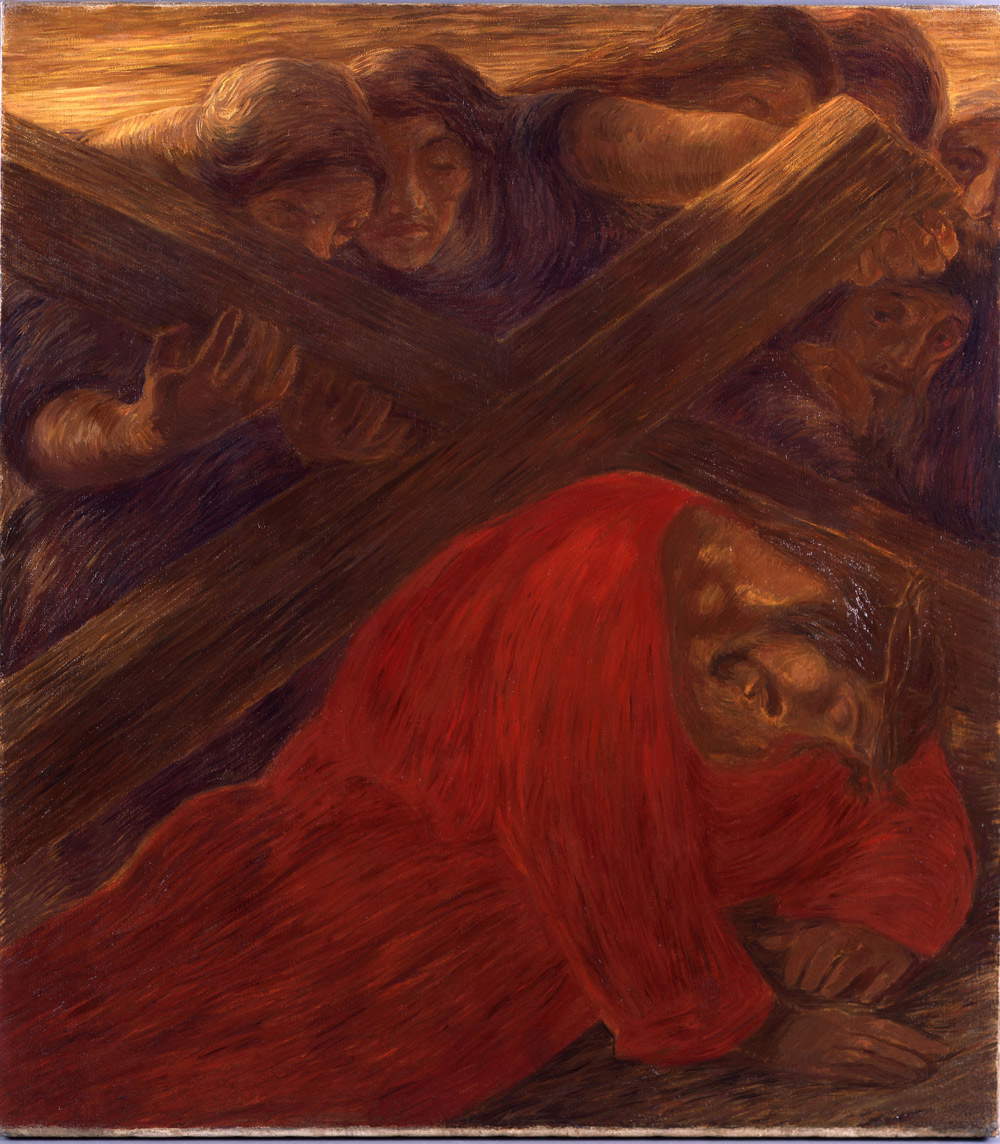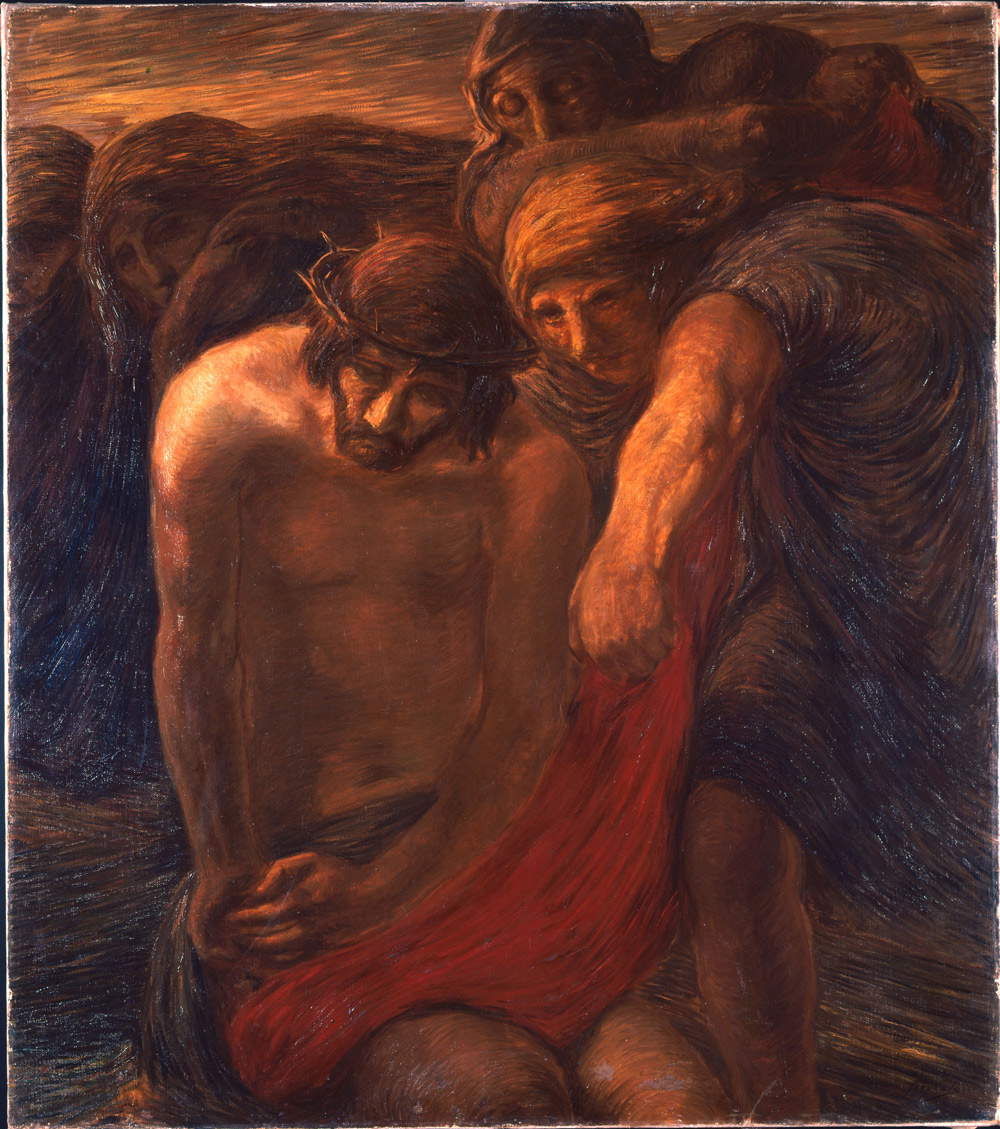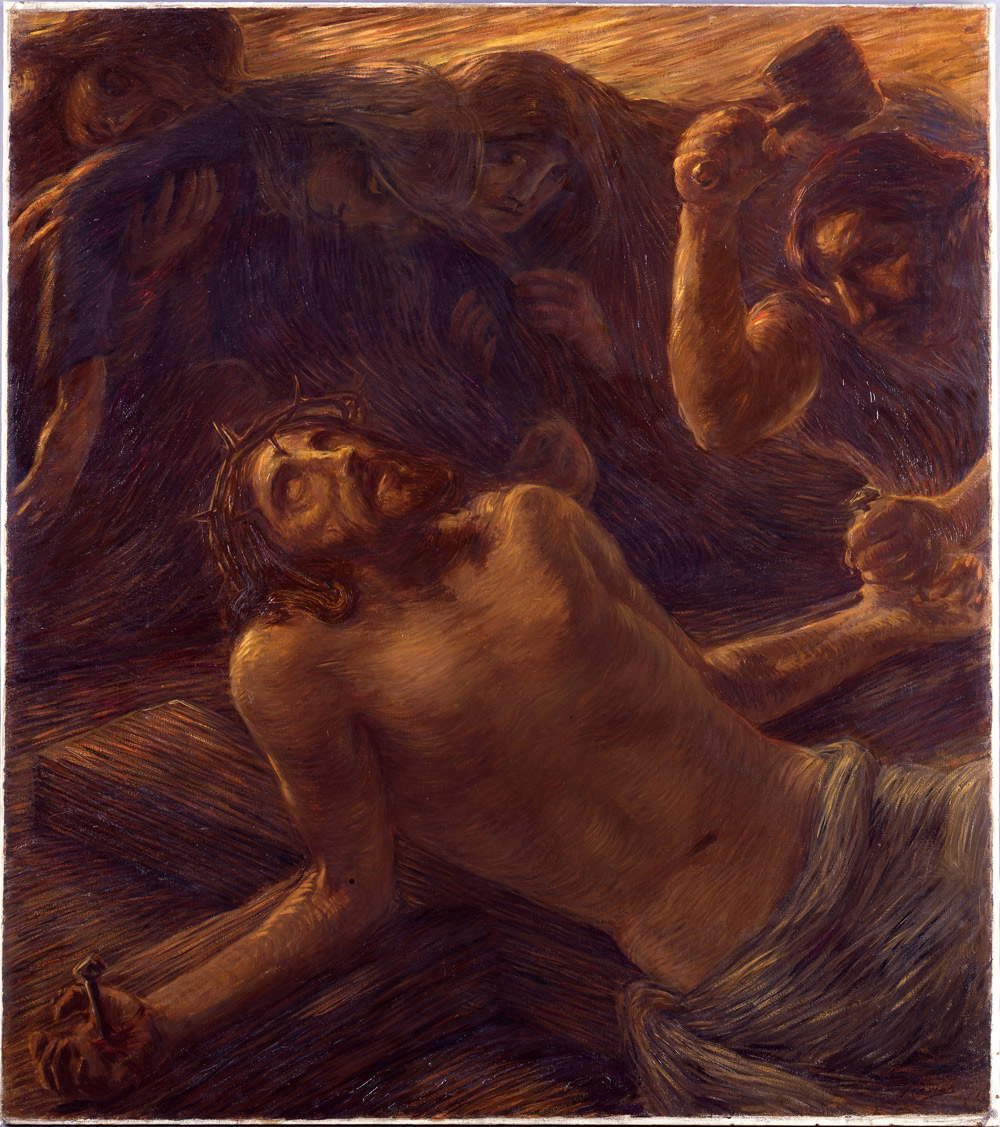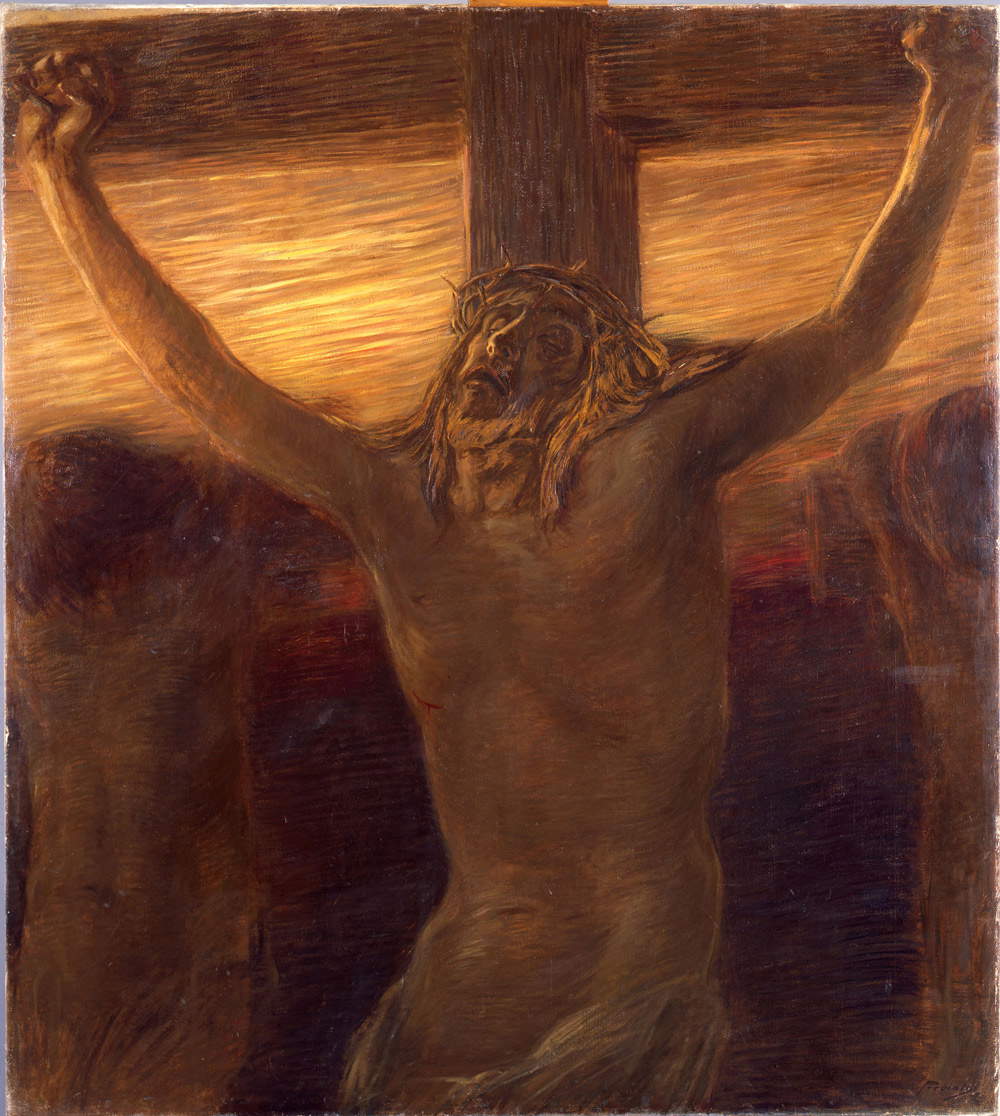by Federico Giannini (Instagram: @federicogiannini1), published on 09/05/2018
Categories: Exhibition reviews
/ Disclaimer
Gaetano Previati's religious painting was extraordinarily modern and innovative: with the Via al Calvario and the Via Crucis he revolutionized traditional iconographic themes and conveyed all his own human feeling.
When Gabriele D’Annunzio came into contact with the art dealer Alberto Grubicy in 1919, the poet was first involved in a publishing venture that was supposed to produce a book on Gaetano Previati (Ferrara, 1852 - Lavagna, 1920), and then he received a proposal to mediate in the context of a sale of six canvases by the great Ferrara painter: the vate already knew Previati’s value, but it was during those exchanges that he had the opportunity to call him "the great artist of the Via Crucis. The Via Crucis to which he was referring was undoubtedly the one that is today kept in the Vatican Museums, but which is not visible to the public: it took almost fifty years to take it out of the papal apartments where it is kept and temporarily make it available to the public on the occasion of the exhibition Gaetano Previati. The Passion, at the Diocesan Museum in Milan until May 20, 2018. The Milanese exhibition, curated by Nadia Righi and Micol Forti, originated from an acquisition: a marvelous Via al Calvario that arrived at the museum through a bequest in his will, and for the occasion it was included in an exhibition itinerary that saw it as the protagonist along with the painting of the same subject from the Cassa di Risparmio di Tortona, the complete Vatican Via Crucis and photographs with silver point retouches by Previati himself, arriving from the parish church of Saints Quirico and Paolo in Dogliani, in the Langhe region.
An exhibition, that of the Diocesan Museum, was interesting for at least two reasons. The first: it made it possible to expose to the public a work that had never been seen before, except by its owners and scholars, and brought back to the light of public enjoyment a valuable cycle to delve into the painter’s intentions. The second: the exhibition has made it possible to make new contributions to the still open discussion on a topic long debated by art historians, that of the religious sentiment of Gaetano Previati, a painter who recovered many of the traditional themes of Christian painting to decline them according to his own sensibility. In order to frame this feeling of the Ferrara painter, it is necessary to start from an article by Enrico Corradini in 1906, which stated that Previati “brought religious, Christian and celestial art back into the seat from which all religious feeling originates, into the original depths of the human soul. In this sense, and for this right, profound reason, he is a painter within the soul.” Previati, Corradini explained, was a religious painter not because he painted Christs and Madonnas, at a time when sacred painting had long since given way to other genres: the religious soul is something that goes beyond belief in a religion, as “conception of life” rather than disposition toward a faith, where by “religious conception of life” Corradini meant “having of life the deepest, most naive and primitive feeling,” “seeing life between mystery and pain, or between mystery and love, or between mystery and terror.” This is the impulse that animates a masterpiece like the Maternity of 1891, which was badly received when it was exhibited at the Brera Triennale that year: despised by public and critics alike, it was defended only by a few who understood its innovative scope. These included Vittore Grubicy, Alberto’s brother, who praised the originality of Previati’s work, supported by its totally “arbitrary character with respect to reality, or to what our eyes are accustomed to consider as such.” Previati, in fact, had wanted to tackle one of the classic themes of sacred painting without external conditioning, without looking to tradition, without yielding to any concession or to the taste of the time, without being guided by any feeling other than his own, as the artist himself declared in a letter to his brother Giuseppe. The result was a painting in which his sensitivity had rendered “all the intensity of maternal love” (to use the artist’s own words) in a dreamy vision, in an apparition that projected onto the canvas the idea of motherhood that Previati lived in his own soul: a universal idea.
In essence, for Previati, religious truth is not fideistic truth: it is spiritual truth. A spiritual truth that, noted scholar Maria Grazia Schinetti in an essay published in the catalog of the major exhibition that between 1999 and 2000 Palazzo Reale in Milan dedicated to the Ferrarese painter, becomes an expression of human feeling. And it is for this reason that his religious subjects break down into scenes that seem to be produced by a dream, that begin to lose their connections with reality: because they spring from an inner, profound reflection, which is located outside time and space, and which the painter tries to render with the tools at his disposal. This reflection, it should be emphasized, does not deny tradition, but is set in dialogue and, wrote art historian Francesco Tedeschi in the Diocesan Museum exhibition catalog, focuses “on details that are profoundly human in nature,” with the result that the “exigencies of an inner necessity” that animated the artist can perhaps, they alone, suffice to “justify the qualification of ’sacred art.’” And if with the Maternity of 1891 Previati had probed the mystery of life, with the Passion paintings he had instead manifested his intention to explore the mystery of death, by means of equally intense works.
 |
| A room in the exhibition Gaetano Previati. The Passion |
 |
| A room from the exhibition Gaetano Previati. The Passion |
 |
| Comparison of the two versions of Gaetano Previati’s Via al Calvario |
 |
| Gaetano Previati, Way of the Cross, 12th station, Jesus crucified (c. 1906-1910; retouched silver-pointed photograph, 31 x 28 cm; DOgliani, Santi Quirico e Paolo) |
In particular, with the two canvases dedicated to the Way to Calvary, Previati intends to address the theme of the Virgin’s suffering by focusing on a passage in the procession that follows Jesus on his tormented way to crucifixion: the painter “focuses on the pain of the Virgin, who appears at the center of an apparently all-female procession, whose beginning and end is not discernible, slowly and laboriously ascending from the city of Jerusalem toward Golgotha” (as summarized by Nadia Righi). We do not see Christ carrying the cross, we do not see his tormentors, we do not see scenes of physical pain. The crucifixion, in this case, is for us a mental image, and for the painting’s protagonists a horrific spectacle that lashes their souls. The Virgin is a mother devastated by the sight of the atrocities her son is undergoing, so much so that in order to continue she needs the help of two women to support and assist her. The bare trees, with their presence as a backdrop, on the left, become an allegory of Jesus’ death on the cross. In the version that has come to the Diocesan Museum, the earthy, dark colors that the artist chose to shape the composition, the heavy air that one almost seems to breathe, and the warm tones of the sky that match the chromatic range of the shadowy figures and those of the hillside all contribute to making the atmosphere much more oppressive and to arousing an even more vivid feeling of sadness.
Different, however, is the approach Previati took for the Via al Calvario now in Tortona, which is about ten years later than the Milan canvas. The latter is probably to be identified, according to the studies that accompanied the exhibition, with the work mentioned in an issue of the magazine Emporium in 1904, in an article written by Vittorio Pica about a group show held at the Grubicy Gallery, in the context of which a number of works that had never been exhibited before were presented, including a “Via del Calvario” that is thought to be the work that later passed into the collection of Carlo Dell’Acqua: the latter, according to information provided by his granddaughter Nella Bolchini Bompiani, who before disappearing in 2016 wanted the canvas to be destined for the Diocesan Museum in Milan, purchased the Via al Calvario directly from Gaetano Previati. We know, however, that the painter had already begun to try his hand at works on the Road to Calvary in 1901, and on the same theme he would later produce the painting now in Tortona, about ten years later, and which differs from the previous variant (which in turn was a reworking, of broader scope, of an earlier 1901 version, now in a private collection) only in its greater formal synthesis and chromatic variations: the tones become colder, the sky becomes blue, the atmosphere more terse, all in accordance with that path of approaching an increasingly abstract painting that the Ferrara artist had undertaken from the moment he began to reflect on his Maternity, and which led to making even Via al Calvario a further “image deprived of ties with reality” because it was born from the depths of the soul, as Maria Grazia Schinetti noted in her contribution on the work on the occasion of the exhibition.
 |
| Gaetano Previati, Via al Calvario (1901-1904; oil on canvas, 80 x 150 cm; Milan, Museo Diocesano “Carlo Maria Martini”) |
 |
| Gaetano Previati, Via al Calvario (1912; oil on canvas, 80 x 150.5 cm; Tortona, Fondazione Cassa di Risparmio di Tortona) |
 |
| Gaetano Previati, Via al Calvario, Milan Diocesan Museum, detail of the Virgin |
And this is also (and perhaps especially) true for the Via Crucis in the Vatican Museums, which the public has not seen since 1969, the year of its last exhibition, shortly before the work entered its current location: it must be assumed that Previati did not paint the cycle for a client, or to place it on the market, not least because at the time it would have been extremely difficult, if not almost impossible, to sell a complete Via Crucis cycle, moreover of that size. The painter painted the cycle for himself, because he felt the need to meditate on the torment of Jesus Christ, in a radically different and renewed way than the way he had approached the same theme some twenty years earlier, when between 1882 and 1888 a Previati then in his early thirties had painted a cycle of the Stations of the Cross for the cemetery of the municipality of Castano Primo, not far from Milan: on that occasion, the artist painted fourteen frescoes strongly anchored in tradition (on the occasion of their exhibition in 2001, again at the Diocesan Museum in Milan, after they were torn from the cemetery for conservation reasons, the work’s dependence both on the great masters of the past was emphasized, from Tintoretto to Tiepolo, as much as from the Passions of Christ of the sacred mountains of the Lombard territory), but independent of the older models because of the monumental setting of the figures that rise to exclusive protagonists of the works, since almost all spatial and temporal references are absent. With the fourteen canvases now in the Vatican Museums, made between 1901 and 1902, which are also monumental, Previati brought further innovations by initiating a complete revision of the way of resolving the iconographic theme of the Way of the Cross, consistent with his contributions made to the renewal of sacred painting and with the research that had led him to the development of his Divisionist poetics.
They are canvases measuring one and a half meters by one and a half meters each, to be exhibited all side by side, probably as Previati had envisioned: and that is exactly how they were placed in the Diocesan Museum exhibition. We have no information about how they had been arranged at the first public exhibition, that is, during the Quadriennale in Turin in 1902, but we can imagine that they had been arranged in a single room, seamlessly, as was the case at the solo exhibition in January and February 1910, when at the Palazzo della Permanente in Milan the fourteen canvases were shown to the public side by side again, on three contiguous walls (this was also the case for the 2018 exhibition: the ten central stations on the long wall, while the first two and the last two on the short walls). The idea, however, was to give the fourteen Stations of the Cross, as Micol Forti points out, “a tight and relentless rhythm, in which light and shadow, color and chiaroscuro, chromatic saturation and mellow tones generate a narrative dynamism.” Even for the Via Crucis, as he had been for the Maternità, Previati was aware of the difficulties that exposing such a cycle to the public would entail: and the reception, in fact, was rather cold. The 1910 exhibition went all but deserted, given also the fact that Previati’s painting did not fully meet the taste of his contemporaries (far from it), while more attention was paid to the painter on the occasion of an exhibition of the Via Crucis at the Palazzo della Cancelleria Apostolica in the Vatican in 1914, but the criticism was not few. The artist had to wait until the following year (and, it bears repeating, this was a period in which theFuturist avant-garde had already begun to furore for some time), with an exhibition at the Carlo Felice’s Reduced Theatre in Genoa, to achieve success.
What Previati proposes to the relative is a continuous narrative of the pain suffered by Jesus during his ascent to Calvary. This was precisely the programmatic intent of the painter who, in a letter also written on this occasion to his brother, expressed his desire to concentrate on the “simplest elements of the station that every painting must represent,” such as “the face of the Madonna and Jesus in the encounter,” while realizing that this was a “superhuman undertaking.” Yet the difficulty of constructing such a complex cycle, which sought to tell not the story of the Passion, but the story of the Passion’s characters, their inner experience, did not prevent Previati from producing a work of great impact, in which he consummates that poetics of states of mind that was the object of investigation of the painters of the time and the basis for the most up-to-date research that the Futurists would develop a few years later, as the exhibition at Palazzo dei Diamanti in Ferrara dedicated to States of Mind has well remarked, moreover capable of establishing a fruitful dialogue at a distance with the Milanese review.
All the scenes are distinguished by the close field, the reduced chromatic range, the frayed brushstrokes typical of Previati’s style from the 1890s onward, and the monumentality of the figures, which, as was the case in the Castano Primo frescoes, overpowers any attempt to reduce the Stations of the Cross to an anecdotal style that did not belong to Previati’s art and would have been at odds with his intentions: particularly illustrative in this regard is the scene with Jesus loaded with the cross, where we barely glimpse (but cannot distinguish) the torturers who have just oppressed Jesus with the burden that will accompany him throughout his ascent to the hill of Calvary. There is no excitement, all narrative intent is lost: Previati’s focus is on the solitary figure of Jesus to convey all his heartbreak. And this applies to every single station: the pain is interior, and there are no bloody scenes (not the slightest drop of blood is encountered throughout the cycle). The reddish hues then, with their direct reference to the blood shed by Christ, burning like living flames only heighten the immense tragedy that unfolds before the astonished and anxious eyes of the viewer. The commotion reaches its climax at the fourth station, theMeeting with the Virgin Mary: the gaze that Jesus and his mother exchange represents one of the most touching moments of the entire cycle, while the synthesis that tends toward abstraction reaches its acme in the last two stations, the Deposition (another masterpiece that moves one to share compassion) and the Burial, with the tones becoming darker to suggest a night that evokes the idea of death (but with, in the Burial scene, a light in the background that already foreshadows resurrection). The summary of the painter’s convictions, however, is to be found in the fifth station, that of the Cyrenean. Micol Forti recalls a conversation Previati had with Nino Barbantini, his friend and fellow citizen, critic and (as we would say today) curator, who contributed to the success of many artists, from Felice Casorati to Gino Rossi. The two had paused to talk about the shoulder of Jesus, and Previati observed that “it is huge; I dare, I see it well myself. But I tried to correct it, to draw it correctly, and Christ would become an ordinary man to me; instead with that shoulder ... ”.
 |
| Gaetano Previati, Via Crucis, Station I, Jesus Crowned with Thorns (1901-1902; oil on canvas, 121 x 107 cm; Vatican City, Vatican Museums, Collection of Contemporary Art) |
 |
| Gaetano Previati, Via Crucis, Station II, Jesus Charged with the Cross (1901-1902; oil on canvas, 121 x 107 cm; Vatican City, Vatican Museums, Collection of Contemporary Art) |
 |
| Gaetano Previati, Via Crucis, Station III, Jesus falls for the first time (1901-1902; oil on canvas, 121 x 107 cm; Vatican City, Vatican Museums, Collection of Contemporary Art) |
 |
| Gaetano Previati, Way of the Cross, Station IV, Jesus meets the Virgin Mary (1901-1902; oil on canvas, 121 x 107 cm; Vatican City, Vatican Museums, Collection of Contemporary Art) |
 |
| Gaetano Previati, Via Crucis, Station V, Jesus aided by the Cyrenean (1901-1902; oil on canvas, 121 x 107 cm; Vatican City, Vatican Museums, Collection of Contemporary Art) |
 |
| Gaetano Previati, Via Crucis, Station VI, La Veronica (1901-1902; oil on canvas, 121 x 107 cm; Vatican City, Vatican Museums, Collection of Contemporary Art) |
 |
| Gaetano Previati, Via Crucis, Station VII, Jesus falls for the second time (1901-1902; oil on canvas, 121 x 107 cm; Vatican City, Vatican Museums, Collection of Contemporary Art) |
 |
| Gaetano Previati, Via Crucis, Station VIII, Jesus meets the pious women (1901-1902; oil on canvas, 121 x 107 cm; Vatican City, Vatican Museums, Collection of Contemporary Art) |
 |
| Gaetano Previati, Via Crucis, Station IX, Jesus falls for the third time (1901-1902; oil on canvas, 121 x 107 cm; Vatican City, Vatican Museums, Collection of Contemporary Art) |
 |
| Gaetano Previati, Via Crucis, Station X, Jesus Stripped (1901-1902; oil on canvas, 121 x 107 cm; Vatican City, Vatican Museums, Collection of Contemporary Art) |
 |
| Gaetano Previati, Via Crucis, Station XI, Jesus is nailed (1901-1902; oil on canvas, 121 x 107 cm; Vatican City, Vatican Museums, Collection of Contemporary Art) |
 |
| Gaetano Previati, Via Crucis, Station XII, Crucifixion (1901-1902; oil on canvas, 121 x 107 cm; Vatican City, Vatican Museums, Collection of Contemporary Art) |
 |
| Gaetano Previati, Way of the Cross, Station XIII, Deposition (1901-1902; oil on canvas, 121 x 107 cm; Vatican City, Vatican Museums, Collection of Contemporary Art) |
 |
| Gaetano Previati, Via Crucis, Station XIV, Burial (1901-1902; oil on canvas, 121 x 107 cm; Vatican City, Vatican Museums, Collection of Contemporary Art) |
The anecdote is significant because it puts us in a position to understand how it was the artist’s precise aspiration to create something out of the ordinary, capable of breaking with conventions, capable of bringing decisive renewals to painting in the sacred sphere, “whose language,” Fernando Mazzocca has written, “had become alien to the horizons of modernity and had become isolated in a timeless academicism.” Previati, through his works, succeeded in giving new relevance to a genre that had long since lost the ability to be modern.
On the sidelines of the exhibition, it is therefore necessary to ask whether the Via Crucis cycle should not be given a new location, perhaps with an arrangement similar to that of the exhibition in the Museo Diocesano, which with the carmine red of the room enhanced the sense of Previati’s work: a work of such fundamental importance in Gaetano Previati’s artistic journey, a set of canvases that, together with the Maternity, the Way to Calvary, the Madonna of the Lilies and other religious works of that period, inaugurated a new language of sacred art, perhaps deserves an arrangement that can enable the public not to wait another fifty years to admire it in all its strong charge of pathos, in all the fascination that Previati’s intimate reflection is capable of exerting, in all its shocking and staordinaria novelty.
Warning: the translation into English of the original Italian article was created using automatic tools.
We undertake to review all articles, but we do not guarantee the total absence of inaccuracies in the translation due to the program. You can
find the original by clicking on the ITA button. If you find any mistake,please contact us.
